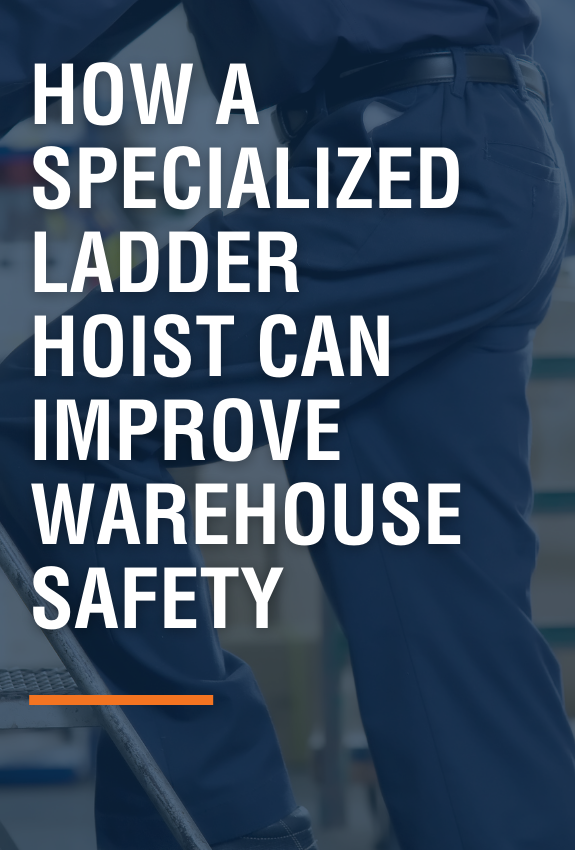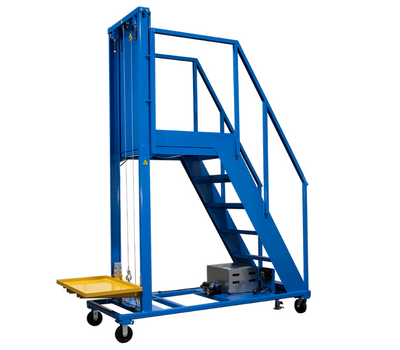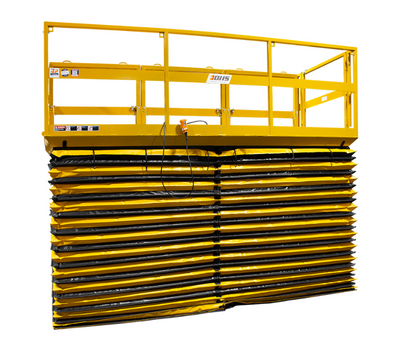We use cookies to make your experience better. To comply with the new e-Privacy directive, we need to ask for your consent to set the cookies. Learn more.
How a Specialized Ladder Hoist Can Improve Warehouse Safety

You may not call it a ladder hoist outside the construction industry, but warehouse employees often need equipment that serves a similar purpose: Safely moving materials vertically along a climbable structure that gives personnel access to elevation.
To explain what we mean, here are three warehouse tasks that become safer and more productive when you employ a specialized ladder hoist designed for the warehousing industry.
Ladder Hoists in the Warehouse: 3 Key Use Cases
In the construction industry, the typical ladder hoist mounts a power drive, platform, and lift cable onto a non-self-supporting single ladder. That’s not the type of hoist that will help in the warehouse. Instead, you need a solution that combines a free-standing ladder with a material lift. Ideally, you’ll have a safe, comfortable work platform at the top of the unit.
In short, you need a Lift Table Ladder from BHS, Inc. This free-standing, mobile unit provides access to high spaces along with a powerful lift platform, capable of moving up to 450 pounds (204 kilograms) the full height of the unit. This type of ladder hoist supports a wide variety of warehouse tasks, including:
1. Stock Putaway
Whether stock arrives in boxes or single pieces, the Lift Table Ladder’s elevating platform provides a safe way to move units to high shelves. The ladder is essentially a mobile staircase, providing comfortable, low risk access to higher levels for any user — complete with anti-skid walking and working surfaces and safety railings all the way up.
2. Order Picking
According to the National Institute for Occupational Safety and Health (NIOSH), workers should “avoid carrying materials and equipment” up ladders. You must maintain three points of contact with the climbing surface, NIOSH says. Carrying materials makes this difficult or impossible.
That’s as true coming down the ladder as going up. That’s why a Lift Table Ladder greatly improves safety when picking orders at height. Users can load orders onto the elevated lift platform, sink them to ground level, then safely climb down and place them onto Order Picking Carts. It’s a faster, safer way to pick orders from upper warehouse shelves.
3. Overhead Maintenance
Stock isn’t the only type of material you’ll handle in a warehouse. Staff must also change light bulbs, service sprinkler systems, maintain IIoT hardware, and any other number of overhead tasks.
Without the right elevated work platforms, overhead tasks require awkward postures that create ergonomic risks. In one study, nearly half the workers who reported frequent exposure to overhead work had neck and shoulder pain, and more than 17% experienced arm pain.
A ladder hoist like the Lift Table Ladder reduces the injury risk in two ways. First, the elevated work platform allows employees to complete tasks without bending their necks or stretching their arms. Second, the lift platform safely moves tools and maintenance materials from ground to work height. This spares employees the risky task of carrying loads up and down a ladder.
A ladder hoist is already an essential tool for construction contractors. With a few additional features, however, such a tool provides similar benefits in the warehousing industry — and anywhere else employees handle materials and work higher than ground level.
To learn more about Lift Table Ladders, Aerial Work Platforms, and other elevated personnel surfaces, contact the BHS sales team at 1.800.247.9500.


